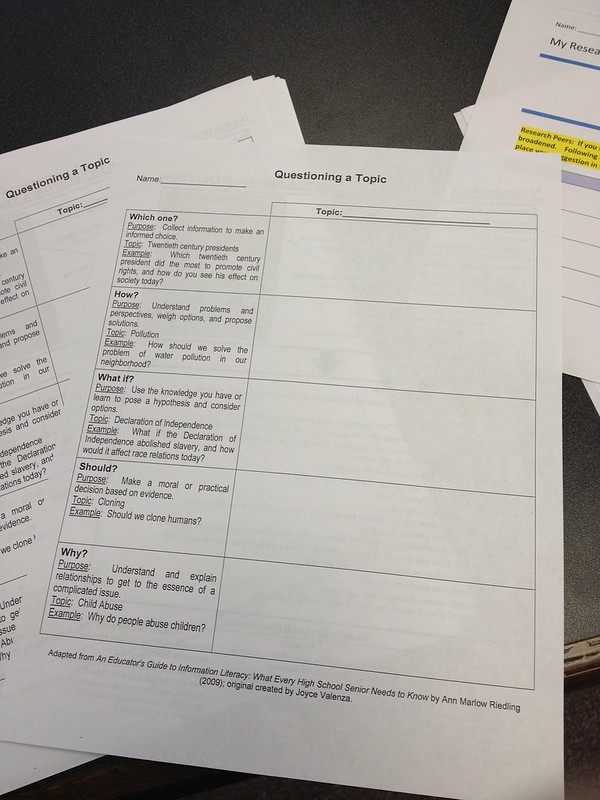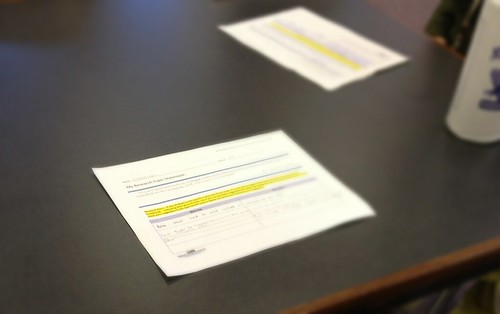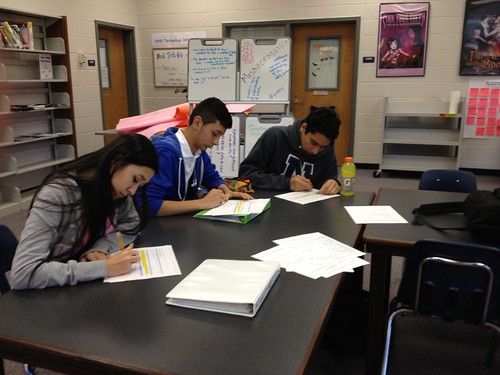In my last post that is part of this series, I shared how we used mindmapping after our second round of pre-searching to begin honing in our a more specific topic for our research.
After students shared out their mindmaps and big ideas, we asked them to look at their topic through different question “lenses” using an activity shared with me by my colleague Heather Hersey, a school librarian in Seattle. Heather, who adapted her version of the handout from An Educator’s Guide to Information Literacy: What Every High School Senior Needs to Know (Ann Marlow Riedling, 2009), graciously shared her template with us, and we used it to help students look at their topic from multiple perspectives by “trying on” a question lens (see below).
This exercise was a stretch for the students as it forced them to look at their topic from an angle they might not have considered; we asked them to see if they could generate a question for at least 2-3 of the question lenses. For some students, this was a helpful endeavor as it helped them in their thinking process about narrowing a focus even more for their topic; other students, though, were a little overwhelmed by the task and/or the cognitive dissonance that came along with the activity. I love the activity because it is yet another way to encourage wonder, but in retrospect, I think it might have been more beneficial had we incorporated it sooner. After conferring with Heather via email, I realized I missed that she utilizes it earlier in the pre-search process; I will consider following her lead on the timing in the future although I want to get student feedback on this aspect before making a decision for future efforts.
Once students had some time to muck around with this exercise, we asked them to then see if they could arrive at a more focused topic and compose a research topic statement or focused essential research question—we wanted to give them the option to write about their more focused in either format. This statement/question writing was the springboard to an activity, “Musical Questions: Broadening and Narrowing our EQs,” that we did on Friday (October 24) that we adapted from Marci Zane, Heather Hersey, Meg Donhauser, and Cathy Stutzman. Sarah Rust came up with her own brilliant take on this activity:
1. We arranged our tables in a conference style arrangement so that students could move about the “square” easily.
2. At the beginning of both classes, Sarah instructed the students to take out their document with the focused research topic statement or question they had composed earlier in the week.
3. We explained that there would be four rounds of peer review; during each review students could provide four types of feedback:
- a suggestion to broaden the topic statement/research question if needed
- a suggestion to narrow the topic statement/research question
- pose a question to nudge the peer’s thinking
- share a constructive piece of feedback to help the peer with fine tuning that statement or question.
We asked that they put their names next to their feedback in case the owner of the statement/question needed to confer with them later about their statements or questions they had shared.
4. We then explained that when there was no music, they would get up and begin walking around the table until music began playing (we let the students choose the music, and interestingly enough, they chose 80s and 90s tunes! Their input made the activity more fun and gave them a sense of ownership). Once the music started, they were to sit down in the closest chair and document and begin writing their feedback to the peer. We gave them roughly 3-4 minutes to provide the feedback before stopping the music and starting our rotation again.
We honestly were not sure what to expect with the activity, so we were delighted by the positive response from our students. We were also joined during our first class by assistant principal Christine Dailey who was there not only as an observer, but also as a participant—her jumping in and working side by side with the students was fantastic and of course, great modeling for our kids. After the four rounds, we asked students to return back to the original seat and work and read over the feedback provided. They then had an opportunity to pair-share with the person sitting next to them and to reflect on next steps or ideas that came from the four rounds of feedback from their peers.
From what we observed, many students found this activity helpful in getting concrete suggestions for being more specific with the wording and in some cases, the scope, of their topic statements/research questions. We definitely would do this activity again as it gave students the chance to collaborate and work together in a meaningful way as we continued to work through our research/inquiry processes! We would like to thank our students for their efforts, Christine Dailey for her time and feedback, and Heather, Meg, Marci, and Cathy for so generously sharing their ideas and experiences with us to create learning experiences that have helped us all as learners.
In addition, a big thanks to our New Jersey/Washington state friends for reminding us that the affective aspects of inquiry that our students are cycling through—confusion/frustration/doubt and clarity—are normal and that activities like these help mitigate some of the emotional lows or challenges our students are feeling, especially as the inquiry approach pushes them out of their comfort zones. Even when you’ve experienced this process with students in the past, it is always reassuring to hear from others their approach to honoring that uncertainty and helping nudge students forward when they get stuck. This same post has also given us some helpful guidance as we’ve wrestled with issues of grading and assessment of process-oriented, formative work.
In my next post, I’ll share how we are moving through the research design proposal process for the multigenre projects that students will be crafting. The next couple of weeks will be interesting as students complete their proposals and move recursively between investigating, constructing, and expressing. Until then, we’d love to hear your ideas and strategies for helping students narrow their topic statements and questions after pre-search–what have you tried that has been successful? We’d love to hear your suggestions!








